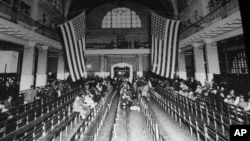1790 Naturalization Act is adopted, stipulating that immigrants can apply for citizenship if they are a free white person of good moral character and have lived in the U.S. for at least two years.
1882 Immigration Act is passed, imposing a 50 cent tax on every immigrant and banning the entry of "any convict, lunatic, idiot, or any person unable to take care of himself or herself without becoming a public charge.”
1891 Office of Immigration is established under the U.S. Treasury Department.
1892 Ellis Island, in New York Harbor, becomes the first federal immigration station. Between 1892 and 1954, more than 12 million immigrants entered the U.S. through Ellis Island.
1903 -1917 New restrictions on immigration are imposed. People with physical or mental defects, beggars, imbeciles, illiterate adults, unaccompanied minors and most Asians are excluded.
1921 Quota Act caps annual entries at 350,000 immigrants.
1924 U.S. Border Patrol is established in part to stop a smuggling business that grew out of Prohibition, which outlawed the manufacturing and transport of alcoholic beverages.
1929 National Origins Act bars Asian immigrants and reduces the annual immigration limit to 150,000 as the U.S. struggles with the Great Depression. The act stipulates 70 percent of admissions should come from northern and western Europe, while the rest should come from southern and eastern Europe.
1942 Bracero Program, instituted by the U.S. and Mexico, establishes a guest-worker treaty for Mexican farm workers in the U.S.
1948 Displaced Persons Act adopted during World War Two, allowing entry of 400,000 people displaced by the war.
1954 Operation Wetback, a drive to deport undocumented immigrants primarily from Mexico, is launched.
1964 Bracero Program ends after sponsoring more than four million Mexicans to work U.S. fields.
1965 Immigration and Nationality Act ends the nationality quotas but caps the number of immigrants welcomed from the eastern and western hemispheres.
1980 Refugee Act creates a system to process refugees separately from other immigrants. The immigration ceiling is separately capped at 270,000 people.
1986 U.S. President Ronald Reagan passes the controversial Immigration Reform and Control Act, giving undocumented immigrants a chance to gain legal status. Nearly three million are granted amnesty. The act also intensified efforts to crackdown on U.S. employers hiring undocumented workers and increased the annual limit on immigration to 540,000 people.
1990 National Immigration Act creates the “diversity” lottery system to encourage immigration from underrepresented countries, and increases the annual immigration ceiling to 700,000.
1996 Illegal Immigration Reform and Immigrant Responsibility Act boosts border enforcement and calls for construction of fences along heavily trafficked areas of the U.S.-Mexico border. Social programs for legal immigrants are reduced and virtually eliminated for undocumented immigrants. Congress mandates jail time for some immigrants accused of committing crimes.
2001 September 11, 2001 terrorist attacks prompts new concern about “homeland” security and prompts heightened scrutiny of incoming travelers at airports, borders and ports.
2001 U.S. Supreme Court prohibits immigration authorities from detaining deportees indefinitely in the case Zadvydas v. Davis. This ruling is referenced frequently in cases involving foreign-nationals jailed after the September 11 attacks.
2003 Department of Homeland Security is created in response to the terrorist attacks, taking over U.S. customs and immigration agencies. Immigration and Naturalization Services turns into Immigration and Customs Enforcement, joining Customs and Border Protection, Citizenship and Immigration Services and nearly 20 other agencies under the newly formed DHS.
2004 A controversial group called the “Minuteman Project” sets up in Arizona, deploying regular citizens not employed by the law enforcement agencies to track down undocumented immigrants.
2006 The Secure Fence Act authorizes the construction of 1,127 kilometers of double-layered fencing along the U.S.-Mexico border.
2007 Secure Borders, Economic Opportunity and Immigration Reform Act fails to pass the U.S. Congress. Major immigration rallies take place across the country.
2012 President Barack Obama passes an executive order allowing hundreds of thousands of undocumented immigrants who came to the U.S. as children to remain in the country without the threat of deportation. The order also allows the so-called “Dreamers” under 30 years old to work.
2013 U.S. Congress debates the Border Security, Economic Opportunity, and Immigration Modernization Act, which would boost border security and give an opportunity for the estimated 11 million undocumented immigrants in the U.S. to gain legal status.




